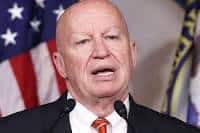
Canadian Minister of Foreign Affairs Chrystia Freeland. She pointedly observed that it is “entirely inappropriate to view any trade with Canada as a national security threat.”
President Trump announced 25% steel tariffs and 10% aluminum tariffs in the name of military security. The tariff announcement will freeze US investments, split Republicans, hurt US allies (especially Canada), and boost the influence of China as an economic, diplomatic, and military power. The Trump tariffs, however, have near unanimous Democratic Party support.
A U.S. stock-market rally that appeared unstoppable just six weeks ago is now at a crossroads, reflecting fears that Trump administration trade restrictions and signs of firming inflation could threaten the underpinnings of the strongest global economic expansion in years,
today’s Wall Street Journal reports. According to another article in today’s Journal:
[US manufacturers] complain that a lack of detail about President Donald Trump’s plan has injected unknowns into their business planning.
“It’s the uncertainty that has many people concerned,” said John Hayes, chief executive of Ball Corp. , a major producer of beverage cans and metal food packaging with about 9,000 U.S. workers. “We don’t know what products it’s on. We don’t know from which countries it’s on. We don’t know how it’s going to be implemented.”
The administration’s most prominent trade hawks took to the airwaves Sunday to play down concerns. They said the U.S. would apply steel and aluminum barriers expansively, leaving no country exempt. [emphasis added]
The weak economic recovery during the eight years of President Obama’s presidency is widely blamed on the economic uncertainty created by his extensive tax and regulatory program. President Trump’s protectionist agenda seems likely to duplicate the Obama administration’s chilling effect on investment, canceling out the brief positive effect of the Trump-Republican tax reforms.
Our weekly trade report by correspondent L.C. provides further detail on the reception of the Trump tariffs by business and political leaders:
Pressure for revision to the announced tariffs is intense. The response to the President’s tough announcement was swift and fierce, and almost universally negative. It came not only from abroad and from domestic metal-using industries and key sectors like energy and automotive but also from Republicans, including many who had supported the President as a candidate. Senate Finance Committee Chairman Orrin Hatch (R-UT), a Trump supporter, decried the proposed tariffs as a “tax hike” that’s “not going to help America.” He pointed out that tariffs “aren’t paid by foreigners,” and said “the tactics we choose must be targeted directly at specific countries and specific practices.” That makes it appear that Hatch – like many who criticized the President’s announcement – would prefer that the US use Section 301, which can be directed specifically at China and at particular trade abuses.

House Ways & Means Committee Chairman Kevin Brady
House Ways & Means Committee Chairman Kevin Brady, who was attending the NAFTA round, said he wants Canada and Mexico exempted, and to exclude from the tariffs “all fairly traded steel and aluminum, not just from these two countries.” He said he hopes the President can be persuaded to back off his universal tariff proposal.
The outcry was not a surprise given the negative response already given to the Commerce Department’s recommendations, even to the weaker of the three alternatives it proposed for each metal. And the President not only chose the harshest option – high tariffs, universally applied – but toughened them further, raising the top rate from the Commerce-proposed 24% to 25% for steel and from the Commerce-proposed 7% to 10% for aluminum. No explanation was given for why he chose these numbers (a White House source told the press he chose 25 over 24 because he thought it was a “nice round number”). It is assumed they did not emerge from the deliberative inter-agency process that is supposed to inform the President’s decisions under Section 232.
It is possible that his final decision might be contested in court, as any government trade action can be appealed to the Court of International Trade, but there are no indications at this time that a court case is being prepared. More likely is a WTO challenge by multiple US trading partners. They may well be aided by the memo by Defense Secretary Jim Mattis undercutting the national security argument (see our last Report). In fact, one of the negatives that some analysts immediately pointed to is the fact that the tariffs won’t hit China directly in any significant way, given the small amount of steel and aluminum it exports directly to the US (and small amount it exports in relation to its economy).
However, they will help China because they will turn the attention of US trading partners away from efforts to cooperate with Washington in fighting Chinese trade abuses – such as through the trilateral US-Japan-EU initiative or through the WTO – and could push them even toward cooperating with China in fighting the US tariffs. (A spokesman for UK Prime Minister Theresa May said that in a phone call with Trump, she “raised our deep concern at the President’s forthcoming announcement on steel and aluminum tariffs, noting that multilateral action was the only way to resolve the problem of global overcapacity in all parties’ interests.” Or as Sen. Lindsey Graham, R-SC, put it, “You’re letting China off the hook. China wins when we fight with Europe.”)
Another negative outcome many analysts warned of is the threat to the WTO and the international rules-based trading system. Using the WTO’s national security exemption (Article XXI) — that allows members to impose trade barriers when deemed necessary for national security — is regarded as the “third rail” of WTO actions because it could pose an existential threat to the institution. Never tested, it doesn’t set guidelines for identifying genuine national security risks, giving great leeway to any country that takes this path. A dispute settlement panel might rule against the US — in which case Washington would claim it went beyond its authority and won’t comply — or it would rule in favor of the US, setting a precedent whereby trade barriers by other countries would proliferate, justified by dubious security interests that can’t be challenged at the WTO.
This week, many analysts pointed to a threat from China in particular: it could declare food imports a threat to its security and could even target its response to block only certain US agricultural exports, for many of which China is the top foreign market. Moreover, making the national security rationale a more acceptable excuse for trade and investment barriers would also help China — because so many of its current restrictions on imports and on the operations of foreign companies in China are based on alleged security concerns (e.g., its Internet, cyber, and financial regulations and its foreign investment limits).
Other potential hazards were also highlighted this week:
- the threat of foreign retaliation, made real by trading partners’ responses to the President’s remarks, citing specific products of political sensitivity to the US as likely targets. Some of these are targeted specifically to hurt districts of important legislators or Trump’s political base;
- the longer-term threat to steel and aluminum producers as their customers, weakened by the rising prices, cut back future demand;
- the threat to US strategic alliances as countries from South Korea to Germany react to being considered non-reliable suppliers;
- the threat to NAFTA as Canada and Mexico respond to not being exempt from the tariffs;
- the unlikelihood of other trading partners entering new free trade agreements with the US now that they see that this wouldn’t even protect them from future US unilateral moves;
- and the commercial danger to metal-using domestic industries as their input prices rise, making them less globally competitive and pushing some manufacturers offshore.
Regarding this last threat, it was widely noted this week that about 145,200 workers work in the US steel and aluminum producing industries, and only about a third of those are actually producing steel (as opposed to working in administration, logistics, etc.). But 6.5 million workers are estimated to be vulnerable to job losses in steel-consuming industries if tariffs lead to sharp hikes in the price of metals.
Longer term, US productivity growth and domestic investment will be threatened as industries enjoying a protected domestic market put fewer resources into innovation and technology to remain globally competitive. Meanwhile, industries using the protected goods as inputs, having now to pay more than foreign competitors, will lose their competitive edge and have less money to invest in upgrading their facilities.
All these risks have been noted before, all the way back to when the President campaigned on a protectionist platform. Yet many of his supporters didn’t take him literally, even though his zero-sum assessment of trade and his complaint that the US is always on the losing side and has to fight back with protectionism is the only policy on which he has been consistent throughout his public career. The Wall Street Journal, in a biting recent editorial, notes that “Protectionism may be his only real policy conviction, and his tweet [that ‘trade wars are good, and easy to win’] confirms he doesn’t know what he’s talking about.” [emphasis in original]

National Economic Council Director Gary Cohn
That he hasn’t acted sooner to impose harsh trade actions – apart from TPP withdrawal – has been attributed to the influence of his more economically mainstream advisers, led by National Economic Council Director Gary Cohn. He reportedly pushed for more limited and targeted tariffs, in an “all-out war” with Navarro, and had been supported by Staff Secretary Rob Porter and Chief of Staff John Kelly (and outside the White House by the Defense, Treasury, State, and Agriculture secretaries). But when Porter was recently ousted following a wife-beating scandal, Cohn and Kelly lost clout with the President, who quickly had Navarro’s status raised to Assistant to the President. In this chaotic situation, protectionist Commerce Secretary Wilbur Ross also gained influence, especially since his recommendations for 232 tariffs jibed with the President’s desires.
Apart from trade, the President is facing several difficult and messy political challenges (the Russia probe, the downgrading of adviser/son-in-law Jared Kushner’s security clearance, the resignation of Communications Director Hope Hicks). He has reportedly reacted with anger and frustration – and this led him to lash out on trade with the harshest possible response. Beyond the risks posed by the tariffs themselves, this situation of turmoil and disarray on the ground at the White House, where policy is affected by the President’s moods, also led some on Capitol Hill and in the private sector to move quickly to denounce the President’s tariff decision –fearing, that, if implemented, it could set off foreign responses that would provoke the President to take even more aggressive action.
This left as supporters of the President’s tariffs only his most trade-hawk advisers – mainly Navarro and Ross (Lighthizer was not vocal on the matter) – the steel and aluminum producers (both company executives and the United Steelworkers union), and Democrats in Congress from metal-producing states as well as Democratic leaders.
On the other side of the unfenced northern US border, Canadian Foreign Minister Chrystia Freeland laid out a startling statistic, given the inclusion of Canada in the tariffs: “The US has a $2 billion surplus in steel trade with Canada [which] buys more American steel than any other country… accounting for 50% of US exports.” She added that it is “entirely inappropriate to view any trade with Canada as a national security threat” and warned that Ottawa would take “responsive measures.”
Click here to go to the previous Founders Broadsheet (“US, European, Japanese markets down sharply after tariff announcement”)

Leave a Reply